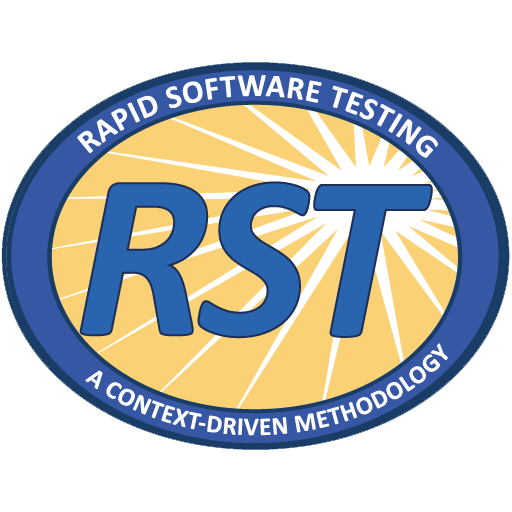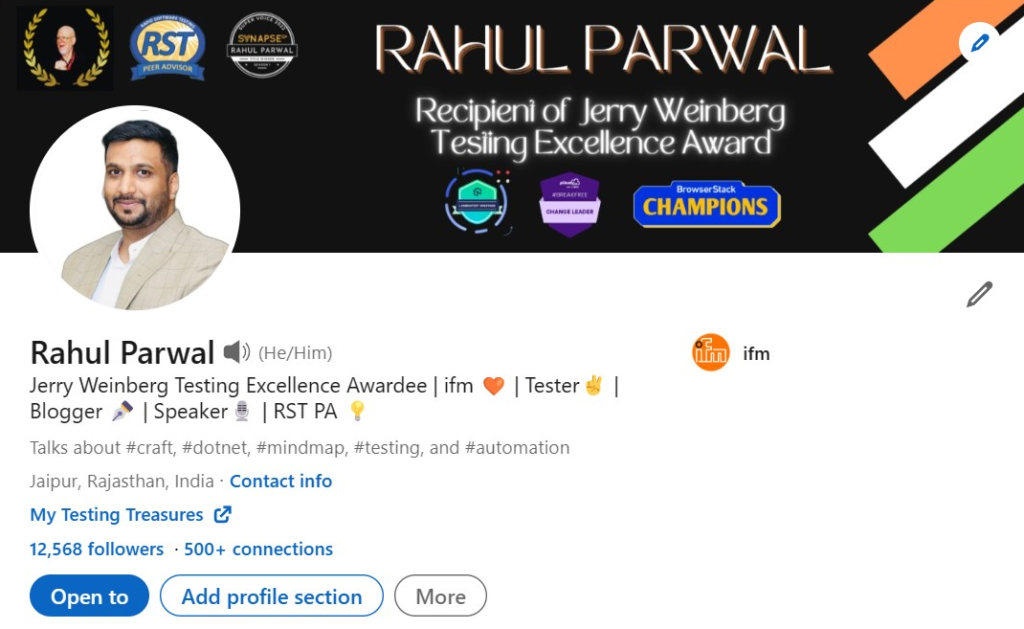Why am I writing this, today? A fellow community member asked this question in a forum today. I think I have some experience in this regard that can help others make well-informed decisions about RST and what you can expect.
Hey Guys, I’m curious to learn about RST and want to see how it helps overall testing activities. Still going through web pages and comparing different RST courses to understand which will suit my requirements. I’m currently pitching the idea to my manager to sponsor the course fee for me but they want a document highlighting: – Context, – Problem, – Solution, – ROI, etc. Ask If you guys have taken any RST courses before, can you please help me to understand the benefits of taking this course and how it helped you on a personal level or if you can share it w.r.t above pointers? This will help me to draft my pitch document and share it with higher-ups to sponsor my course fee.
Kunal Ashar, Discord Forum, The Test Tribe
My experience with RST:
I have done 2 RST Classes till now (Feb 2023):
1. RST Explored – Rapid Software Testing (rapid-software-testing.com) – Sep 2021 (As a Student)
2. RST Applied – Rapid Software Testing (rapid-software-testing.com) – Oct 2022 (As a PA – Peer Advisor)

Did I know about RST before I attended Formal RST Classes? Yeah! A lot 🙂 How? 👇🏼
- Had studied RST materials in bulk volumes over the last 2-3 years. Thanks to free materials, articles, and info available here:
- Watched almost all the conference talks that you can find by searching for James Bach, and Michael Bolton on YouTube. At one point in time, I had replaced Netflix with this stuff.
- Had attended one sponsored public test consultation with James Bach back in 2020. It was a gift that I had gotten from The Test Chat community as I was one of their hackathon winners.
- Had interacted, read, and witnessed James in Testing Communities, Social Media Platforms, and a Mythology Group of which we both were a part of.
- I asked James questions via DM about my doubts about his material or blog posts, and he always answered them. He also gave me follow-up thought experiments and left me richer in testing knowledge than before.
What did I Learn?
Although the RST syllabus is quite deep and comprehensive (Check here: Home – Rapid Software Testing (rapid-software-testing.com)), These are some of the things that I see in me after attending RST:
- Testing vs Checking: For folks, who don’t know me: I was a developer turned automation scripter. I just wanted to automate all testing. Once, I started to study RST materials, I realized how testing could not be automated. Also, I understood the concept of checks and automation scripts. When I meet and talk to folks in the testing space, 90% don’t know this difference. I feel understanding this is core to the idea of testing.
- Testing != Quality Assurance: People confuse testing and quality assurance. It is a misnomer. Not sure who sold this idea here but my job as a tester is not about assuring quality. It’s about finding valuable information that can help my stakeholders make well-informed decisions. Testing is like the headlight of my project. It can show what’s hidden in the dark.
- Testing != Test Execution: The majority of the industry is stuck in associating testing with its execution mode and identifies it as “Manual” Testing or “Automation” Testing. After RST, I realized how testing is much more than mere execution. Testing happens with the mind. It involves a lot of things and how each and every aspect of it from requirement exploration to risk analysis to survey testing to active research to reporting to what not is important to be a credible, influential, and value-adding tester.
- Testing Tools != User Simulation Tools: While most folks are stuck with user simulation automation using tools such as Selenium, Appium, XYZium, It is essential to think of tools to help you with different tasks in testing. I started my hunt for micro tools to help me with different activities in testing and could eventually make an ebook on such micro tools to boost productivity as a tester: Ultimate Productivity… by Rahul Parwal et al. [PDF/iPad/Kindle] (leanpub.com)
- Heuristics, Oracles, HTSM: These three things are like fuel to my testing today. Whenever I start my testing, these things help me to drive, & strategize my testing game. I could understand that the words, “Heuristics” and “Oracles” might be hard to understand for the first timers (Yes, they were hard for me too.). However, they are crucial topics in testing. Not sure why no one else talked about them before RST to me.
- Measurement of Testing: I learned how counting bugs, test cases, test scripts, etc. was like counting cookies and a proxy measure. I also got to know about SBTM (Session Based Test Management) sessions.
- Systematic Testing vs Unstructured Testing: Before, I used to think of exploratory testing as some kind of ad-hoc or unstructured work. With RST, I learned about how to make my testing work systematic and efficient. I also learned about testing notes, charters, missions, etc.
- Survey Testing, Sympathetic Testing, and Product Coverage Outline: These are like building blocks or foundations of good testing work. If you care about doing excellent formal testing (test scripts, checks, cases, etc.), you need to be excellent at informal testing and work. These concepts are pillars of that.
- Bootstrap Approach to Learning
- Explicit vs Tacit Knowledge: Use of both, and how explicit knowledge can give wings to your tacit knowledge. This course is a lot about how to use your mind for better thinking. Thinking Fast vs Thinking Slow. You will become a better thinker after RST.
- Visual Intelligence & Right Brain Tools: Visual Intelligence is a superpower. Everyone has it; Only a few use it. In RST, you will also learn about how to harness this visual intelligence for your test design, modeling, and other needs.
- Testability: It is a superpower. It makes testing easy. How to ask for it? Different types of testability.
- Biases & Mental Models: Biases affect testing. Dev Mindset vs Tester Mindset, Importance of De-Biasing, etc.
- Formal Testing vs Informal Testing: How they complement each other. How to be good at both to take your testing game to the next level.
- The reality of Agile, DevOps, Shift Left, Certifications, Standards, etc.
While discussing this blog in RST Slack Channel, another RST alumni – Michael Ryan Skolnik | LinkedIn shared his experience too:
- RST provides insight into the nature of competent software testing and the tester’s role in it. This makes testers more credible as part of teams, helps align incentives, and makes them easier to work with. (For example, moving from quality gate to someone who provides information about risk)
- RSTA/F gives you a chance to work on testing assignments, get feedback from expert testers, and get exposed to how other RST students from other organizations approach testing things. That all helps the tester and business alike.
- For me, RSTA demonstrated the possibility space of the testing career. If the tester wants to be a career tester, and the org wants people to develop as testers rather than thinking it’s a role that’s only a stepping stone into product, development, or scrum master roles, RST is helpful. The less specialized knowledge about testing the org has, the more helpful it is.
- Related, risk assessment and system modeling are interesting and powerful techniques that RST emphasizes uniquely (from what I’ve seen).

ROI for a tester:
- My testing approach changed drastically after RST. It helped me be a different tester and a better one.
How do I know that it was better? Look at the testing contests that I won in the last 1-2 years after applying this knowledge: Contest Wins – Testing Titbits | Rahul Parwal - I made a testing portfolio. Most of the work in my portfolio is a direct reflection of the stuff that I learned in RST. Check it out here: Home – Testing Titbits | Rahul Parwal
- I started going more deeply into testing, rather than focusing on shallow checks or using simulation tools, or other non-relevant stuff.
- The feedback from my customers at work improved positively after RST. Now, my customers even ask me for consultation on testing problems outside my initial work scope.
- Lifetime Access to RST Slack Alumni Community – Access to around 5k+ professional and serious testers from around the world. Reading, & Engaging in discussions with them is very enriching for learning and continuous growth.
- Maturity as a Testing Professional

ROI for Tester as shared by RST alumni – Michael Ryan Skolnik | LinkedIn:
- Be better able to conduct risk analysis, test strategy and planning, and testing.
- Be better able to communicate the work, outputs, and value of testing. I’d say this aspect of RST was the main extrinsic driver of my career and salary growth over the last 7 years.
- Access to a testing community.
ROI for an Organization (Shared by Michael Ryan Skolnik)
- More contextualized, focused, testing –> better product understanding and potential for better product outcomes (if the tester finds important issues and the org acts on them). High value relative to cost.
- Can help retention of testers.
NOTE: This is in progress, I will update it more. Right now, on a little crunch with time.
If you liked this article, you can check out this popular post from my blog hits:
Pingback: 7 Testing Courses Worth Trying: Unlocking Real Tricks of the Trade - Rahul's Testing Titbits